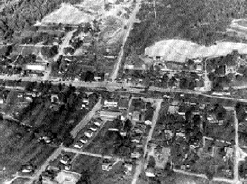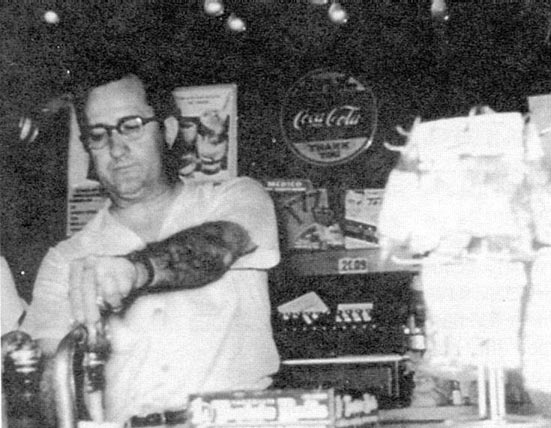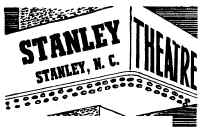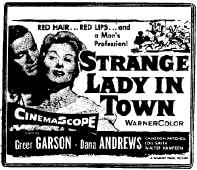


















|
Early 1900's
|

|
|
Downtown Stanley sometime just after the turn of the 20th Century. This is a
picture of the buildings on the West side of the railroad.
|
      
After the War Years
|
 |
| Downtown
Stanley in the late 1940's.
Click on the image to view full screen. |
From 1945 and after, much was the same as it had been before the war. Stanley was still considered by other parts of
the county as the "country." Doctors were still going on "house calls" to visit the sick; the
milkman still delivered milk in glass bottles to individual homes in town; and the iceman was still
delivering ice to the homes who left a card posted outside indicating the number of pounds of ice
they desired. The iceman then delivered the ice into the home and placed it in the icebox.
Stanley, as well as the rest of the country, was still segregated racially - black people rode in the
back of buses, drank from fountains marked "colored only," and had their own schools. In Stanley,
the "colored" school was still Springfield School on the road to Dallas.
There was no television and movies were mostly black and white. This form of entertainment, (movies),
was a favorite not only as a sense of escape to another world, but the theatre was comfortable and
cool because it was air conditioned.
Most homes did not have air conditioning and many people spent summers outside or with all windows
open. Crime was not prevalent and people felt safe, not many people even locked their doors when away
from home.
During the war years many women went, for the first time, to work on jobs away from home, to fill in for
the men away fighting the war. However, after the war was over most women returned to their jobs as
homemakers. In Stanley, even before the war, many women worked in the textile mill and continued to do
so through the war and after.
Lots of family farms were still in existence around Stanley. Young boys and girls delivered
newspapers around town, usually on their bicycles.
Gaston Children Quarantined
Because of the polio epidemic in Gaston County in July of 1948 all children under the age of 16 were
quarantined; they were forbidden to assemble at playgrounds, swimming pools, moving pictures, Sunday
schools or any other gathering place. For the most part all that summer the children of Stanley stayed
close to their homes.
Up until that point it was not known what caused polio and a prevention had not yet been discovered.
Because it was thought that files and mosquitoes were secondary carriers of the disease the County
Health Board authorized the spraying of the county with the pesticide DDT. All towns, including Stanley,
were sprayed.
School Burns
The Stanley Graded School was totally destroyed by fire on January 22, 1947. School was in session at
the time but everyone escaped the building safely.
See
"Schools"
Cauble's "Drug" Store
 | |
B. J. Cauble in his drugstore on corner of East Chestnut and Highway 27 |
B. J. Cauble operated Stanley Sundries for about 20 years. Everyone in town called it
the drugstore, however, there was no pharmacy, it was actually a soda shop. It was in this
soda shop that people bought tickets and boarded the Trailways
buses to travel to Charlotte or Lincolnton for shopping, seeing the doctor, etc.
During several years in the 1950's Mr. Cauble also owned and operated a cafe
on N. Main Street, in the next block north of the soda shop. The cafe was a favorite
gathering place after ball games, for teenagers to drink cokes or hot chocolate
and listen to records on the juke box.
|
Stanley Theatre
 |

|
Lewis S. Ballard, Jr. announced in the Gastonia Gazette of July 3, 1948 that the (new) Stanley
Theatre would be open for business on the next day,
July 4. The theatre business was actually owned by
Charlie M. Lowe and Mr. Ballard was manager.
Mr. Lowe purchased a lot from Luther J, Sherrill
on East College Street to build the 40 x 120 foot
brick building in which they would operate the
Stanley Theatre.
Lewis and Sue Ballard operated the Stanley
Theatre until 1952, when Bill and Betty Abemethy
Smith became the managers.
The theatre had a balcony and in those days,
before integration, the balcony was used by the
black citizens of Stanley and other parts of Gaston
County, who came to the "show." It was one of the
few theatres that allowed black citizens in those
days.
Many of Stanley's citizens who were children
during the 1940's and 1950's can remember the Saturday westerns at the movies as well as the short
serials that were shown before the feature of the day. On some special occasions stage shows were
held in the movie theatre. Once Gabby Hayes, a Hollywood star of western movies, entertained on the
Stanley Theatre stage.
Bill Smith had a great interest in science and obtained all films he could pertaining to anything
scientific. So Stanley's children saw all the science fiction movies about space ships and trips
to the moon, which later became true to fact.
Jack Sipe began working with Bill and Betty Smith, running the projector, etc, sometime in the 1950's
or 1960's. Pete Black managed the theatre next for a few years and Jack Sipe continued to work
for him.
Then the theatre was sold to Fred Payne who managed it for just a short time, with Larry Bennett
running the projector, before it was closed forever. The shell of the building, with no roof, stands
today in
1997, as a reminder of all the enjoyable times Stanley Citizens, especially the children, had watching movies
at the Stanley Theatre.
New Post Office
Stanley got a new post office in 1948. Previously located on the east side of the railroad in the
McLurd building it moved across the tracks into a new building. Patrons were learning to use the
combinations on their new boxes. Jack Bentley was acting postmaster and eventually Lee Cherry was
made postmaster.
Traffic Lights
Because of increased traffic in town and a need to control speed and the potential for accidents,
the town officials installed Stanley's first traffic lights in April of 1948. A stop light was
placed on Highway 27 at the crossing just above the depot and caution lights were placed at the
intersection in front of Stanley Mills and one at the intersection of Highway 27 and the old Mt. Holly
road.
      
[ The Museum ] [ Contact Us ] [ Stanley History ] [ Photo Galleries ] [ Citizens ] [ Recollections ] [ Schools ] [ Churches ] [ Community ] [ Recent History ] [ Order the Books ] [ Topic Index ] [ Site Index ] [ Search ] [ Acknowledgments ] [ Related Links ] [ Guestbook ]
|
|





